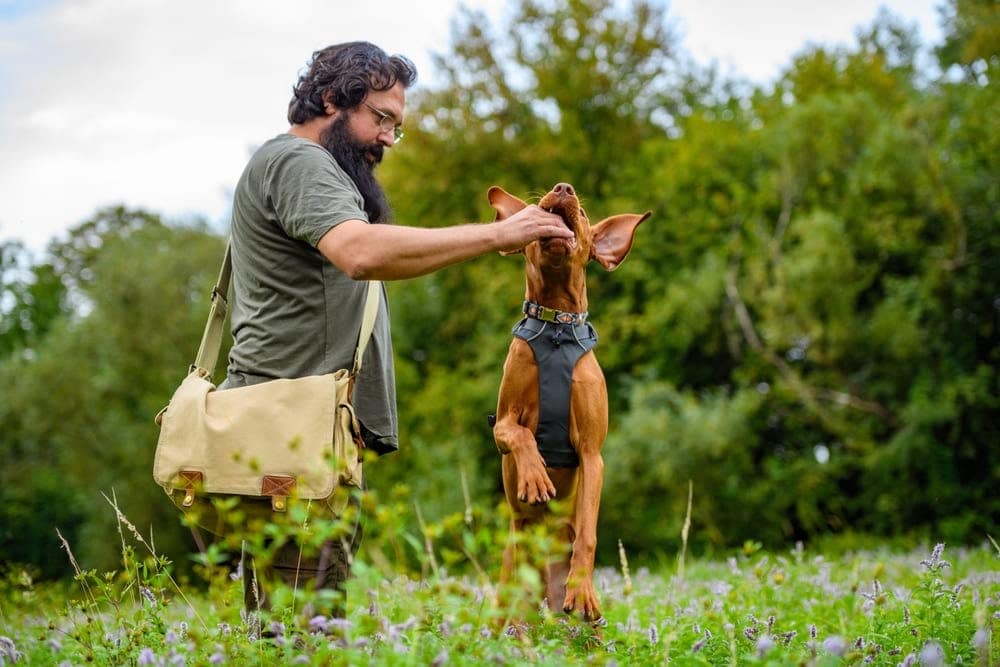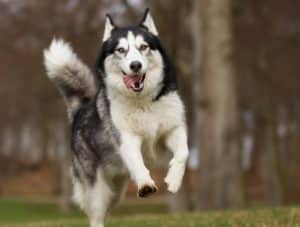Teaching your dog commands is essential for effective communication and building positive relationships.
Whether you have a new puppy or an older dog, teaching them to obey commands can make your life easier and improve your overall well-being.
Here’s a breakdown of dog training using positive reinforcement, including key takeaways:
What is Positive Reinforcement Training?
- Focus on the Good: Rewarding desired behaviors makes your dog eager to repeat them.
- Rewards = Motivation: Treats, praise, toys, or play – whatever your dog loves!
- Success Builds Confidence: Dogs learn best when they feel safe and happy trying new things.
- Strong Bond: Your dog sees you as the source of good things, making them want to please you.
How to Do It Right
- Choose the Treats Wisely: Small, yummy, and easy to eat quickly. Experiment to find favorites.
- Timing is Everything: The instant your dog does the right thing, say “yes!” and give the reward. Slow timing confuses them.
- Short and Sweet Sessions: Keep it fun, especially for puppies. A few 5-10 minute sessions a day are ideal.
- Be Patient & Consistent: Every dog learns at their own pace. Stick with it and they’ll get it!
Tips for Teaching Commands
- Start with the Basics: “Sit”, “stay”, and “come” are building blocks for more complex skills.
- Break it Down: Big commands can be overwhelming. Teach one small step at a time. (Example: Lie down, then add a hand signal, then the word “down.”)
- Consistency is Key: Use the same word and hand signal every time you give a command.
Key Takeaways
- Positive Training Works for Everyone: It’s effective with every breed, age, and personality.
- It’s About Building a Relationship: You’re building trust and communication, not just teaching tricks.
- Happy Dogs Learn Best: Positive training creates a fun, low-stress environment for both of you.
Want to get started? Here’s how to teach “Sit”:
- Hold a treat in front of your dog’s nose
- Slowly move the treat up and over their head. Their butt should naturally go down.
- The second they sit, say “YES!” and give the treat.
- Repeat! If they stand, start again. It might take a few tries.
What Does Positive Training Mean For A Dog?
In this article, we will explore in detail what positive training means for a dog. So, discover on the Terranimo online pet store what positive education for a dog means.
From the philosophy behind it to practical techniques, discover how to apply this approach to establishing a harmonious relationship with your four-legged friend.
Positive education is learning based on stimulating the dog through a reward. It allows both to guarantee the good emotional state of your animal but also continuous and lasting learning.
Do not pull on your leash too much during walks, cleanliness or even socialization are examples of things that your dog can learn through the prism of positive dog training. To avoid the appearance of behavioral problems, it is better to start as early as possible!
What Are The Precepts Of Education And Positive Reinforcement?
The primary goal of using positive reinforcement in doggie training is based on the analysis and understanding of the animal’s behavior. The owner and/or trainer lead the animal towards the expected behavior by working on its confidence and seeking its cooperation. Before you begin, you will need to determine what motivates your dog the most. Positive education is based on several trends:
- Learning through cooperation;
- Clicker training;
- Education by mimicry.
Learning through cooperation is the gentle method that uses neither constraint, violence, or domination to teach the animal to evolve within our society.
Dog and human are equal, no one dominates anyone. However, some dog trainers and behaviorists are sounding the alarm, because the hierarchy secures the dog and also helps protect your dog’s people if he decides not to obey. Human decision guides the dog in the face of the dangers it might encounter.
Relying on the Pavlov reflex and conditioning, clicker training is activated each time your little one adopts the expected behavior. We immediately reward the animal with a treat, each time. As the sessions progress, we will reduce the number of times we give the treat.
With mimicry training, the master relies on the dog’s predispositions and preferences to guide him. It is also based on the fact that the puppy or adult animal will naturally reproduce the actions of its owner.
So, when the dog sits, we will associate the word “sit” and a single gesture. The animal then associates the gesture and word used with the action it has carried out. We will reinforce this attitude with a treat, a caress, or a game.
How To Use Positive Reinforcement Correctly?
Overall, the positive reinforcement method is one of the most effective and ethical dog training methods. It can be used for many types of training, including basic education, correcting bad behavior, and even teaching highly mental tricks.
However, its effectiveness depends on proper application and consistency, as well as how well you understand your dog and his needs. Be sure to get proper training before you begin training your dog.
Start Training With Simple Commands:
Start training with simple commands to help your dog understand more easily what is required of him. Once she has learned the basic commands, she can move on to more advanced tricks and actions.
Use Appropriate Rewards:
Choose rewards that are most appropriate for your dog. This could be food, toys, or praise, but the main thing is that the reward is sufficiently motivating for the dog.
Be Consistent:
Continue training regularly and be consistent in your use of positive reinforcement. This will help the dog better remember the commands and behavior that is required of it.
Don’t Use Punishment:
Don’t use punishment or harsh physical force to get the desired behavior. This can lead to stress and increased anxiety in the dog.
Use Positive Reinforcement with Appropriate Training:
Before you start using positive reinforcement, be sure to learn the basics of dog training and get training from a professional dog trainer.
Don’t Forget Socialization:
Training your dog with positive reinforcement alone is not enough to make him a well-behaved dog. Socialization is a key factor in developing healthy and balanced behavior in your dog.
How To Use Positive Reinforcement For Command Training?
Teaching commands will benefit both you and your dog. This helps establish a clear line of communication and sets boundaries, making it easier for your dog to understand what you expect of him.
Plus, it strengthens the bond and builds trust between you and your furry friend. Additionally, teaching commands can keep your dog safe in a variety of situations, such as reminding you when he’s off-leash or preventing dangerous behavior.
Start with Basic Commands:
When teaching a dog a command, it is important to start with the basics. Start with basic commands such as “sit,” “stay,” and “come.” These commands are easy to learn and form the basis for more advanced training later on. Remember to use consistent verbal and hand signals when giving commands to your dog.
Sitting Training:
To teach your dog to sit, bring a treat to his nose and raise your hand. As their nose follows the treat, their buttocks naturally drop into a sitting position. When they sit, praise them and reward them with a treat. Repeat this process several times until your dog associates the word “sit” with the action “sit.”
To teach your dog to stand, give the command and then take a step back. If they stay put, praise them and reward them with a treat. Gradually increase the distance and duration of the “stay” command as your dog becomes more comfortable and responsive.
Teaching your dog to come when called is critical to his safety. Start in a quiet and familiar place. Sit down, open your arms and enthusiastically call your dog’s name, then give the command “Come.” Reward them with praise and a treat when they reach you. Gradually move to a more distracting environment to increase your child’s response to the command.
Positive Reinforcement:
Positive reinforcement is a key component of effective team training. Dogs respond best to praise, rewards, and treats when they demonstrate desired behavior.
Whenever your dog successfully follows a command, immediately reward him with verbal praise, a treat, or a combination of both. Consistency is critical, so be sure to reward them every time they follow a command.
Break Commands Into Simple Steps:
Breaking down commands into smaller steps makes them easier for your dog to understand and follow.
For example, if you want to teach your dog to roll over, start by teaching him to lie down first. Once they have mastered the “down” command, you can gradually introduce rolling over, rewarding them at each step of the process. By breaking up complex commands, you avoid overloading your dog and ensure a higher success rate.
Consistency and Patience:
Consistency and patience are paramount when teaching your dog commands. Dogs learn through repetition and reinforcement.
Set aside regular training sessions, preferably in a quiet, distraction-free environment, to practice commands with your dog. Consistency in your training methods, cues, and rewards enhances your dog’s understanding and minimizes confusion.
Patience is required as dogs progress at different rates. Avoid disappointment and remain calm and positive throughout the training process.
“Understanding the nuances of effective training techniques is essential for any learning process, be it for humans or animals. In the realm of pet care, Dog training particularly vital as it not only shapes obedient behaviour but also fosters a bond between the pet and its owner. Programs like those offered at Brain Training for Dogs provide in-depth insights and practical approaches to dog training. Their methodologies emphasize mental stimulation that goes beyond the basics, ensuring a well-trained and mentally agile pet.”
Advantages and Disadvantages of the Positive Reinforcement Method:
Positive reinforcement is one of the most recognized and effective methods of dog training. It is based on the use of rewards or rewards for desired behavior, while undesirable behavior is ignored.
This method can be used to teach various commands, tricks, and other skills. However, like any dog training method, positive reinforcement has its pros and cons and requires the right approach to achieve success.
Advantages of the Positive Reinforcement Method:
Training your dog is no easy task. This requires patience, willpower, and a method! In recent years, a new training technique has emerged: positive education.
Based on cooperation and mutual understanding between the master and his animal, this method adapts to the dog’s personality, pace, and needs. Here’s everything you need to know about positive education for our four-legged friends.
Effectiveness:
Positive reinforcement is one of the most effective dog training methods. Dogs learn quickly when they are rewarded for desired behavior.
Safety:
Because positive reinforcement is based on rewards, it is one of the safest methods of dog training. He does not use punishment or harsh physical force that could harm the dog’s health.
Strong Bond:
When a dog receives praise and rewards for desired behavior, it helps him develop a strong bond with his owner. The dog becomes more trusting and inclined to follow the owner’s instructions.
Positive Atmosphere:
The positive reinforcement method creates a positive atmosphere during the training process, which helps the dog feel comfortable and confident. This reduces the stress and anxiety that can occur with harsher training methods.
Encouraging Successful Learning:
Training treats create a positive dynamic between you and your dog, encouraging clear communication and mutual understanding.
They make training sessions enjoyable and encourage your dog’s engagement in the process. By combining these delicious rewards with positive reinforcement techniques, you will create a training-friendly environment, where your difficult dog will be motivated to develop new skills and respond enthusiastically to your directions.
In short, dog training treats are much more than delicious snacks. They are powerful tools for encouraging desired behavior and strengthening the relationship between you and your companion.
With carefully selected treats, strategic use, and a positive attitude, you will create successful skill acquisition that will make your dog’s eyes shine with every step of his progress.
Strengthens the Bond:
First of all, it strengthens the bond of trust and respect between you and your dog. By using gentle and caring methods, you promote a harmonious relationship based on mutual understanding.
Caring Education:
Training approaches that rely on fear or pain have no place in responsible education focused on basic commands.
The use of choke, prong, electric collars, or punitive methods such as yelling, pushing, hitting, or pulling on the leash should be avoided, especially in a dog sensitive to positive teaching methods. These methods have not only been shown to be ineffective for skill acquisition, but they can also increase anxiety and aggression in dogs, even leading to fear of their owners.
Avoiding these methods is essential to creating a healthy and positive training environment for our faithful companions, while encouraging the dog’s assimilation of training and reward techniques.
Disadvantages of the Positive Reinforcement Method:
Positive education works with a system of repetition and rewards. Please note: this is not about stuffing your dog with treats all day long.
The rewards can be diverse and depend on the dog’s personality: treat, caress, encouraging words, or play session. However, there are some disadvantages of positive reinforcement. These are…
Ineffective in Crisis Situations:
Positive reinforcement may not be effective in situations where the dog is in crisis or is under extreme stress. In such cases, a more forceful approach may be required to control the dog’s behavior.
Ineffectiveness without Consistency:
Positive reinforcement requires consistency and consistency in application. If training is not done regularly, the dog may forget how to perform a certain command or action.
Reward Dependency:
Dogs that are trained with positive reinforcement can become reward-dependent. They may not follow a command if they don’t see the reward or if they don’t receive it in the amount they are used to. This can cause the dog to expect a reward for every behavior, which can make it difficult for him to behave in the future.
Limitation of Use:
Positive reinforcement is not suitable for all dogs or all behavior types. Some dogs may be too aggressive or nervous to be trained this way. These dogs may require a more forceful approach to control their behavior.
How Do Professional Dog Trainers Incorporate Positive Reinforcement Training Into Their Practices?
Training a dog is very important and even if there are some basic rules to follow to go about it correctly, it is sometimes necessary to call on a professional, particularly in the following cases:
- When you have just adopted a puppy and want to teach it the basic rules of obedience,
- When the dog exhibits problematic behaviors,
- When you want to create a real relationship of trust with your animal,
- When you want to learn the rules of positive education.
A dog trainer has the knowledge, experience, and skills to assess your dog’s behavior and design a training plan tailored to their specific needs.
They can guide you in good training practices, teach you proper techniques, and help you build trust with your dog. They can also come to your home to assess the environment and advise you on the layout of the animal’s space.
The dog trainer will work with your dog as well as with you to give you all the keys to creating a beautiful relationship with your animal.
Some dog trainers offer services before adoption aimed at supporting you in choosing your animal. This is a great help in finding the puppy or dog that suits you based on its breed and characteristics.
Conclusion:
Teaching your dog commands is an investment in his well-being and your relationship with him. Remember to start with the basics, use positive reinforcement, break commands into simpler steps, and remain consistent and patient. With time and dedication, your dog will begin to respond to your commands, enriching your life together.
FAQ:
How long does it take to teach a dog to respond to commands?
The time it takes to train a dog varies depending on factors such as breed, age, and individual temperament. Consistent training and positive reinforcement can show results within a few weeks, but some dogs may take longer.
Can older dogs learn new commands?
Absolutely! Dogs of any age can learn new commands. Although puppies may learn commands more quickly, older dogs can still be taught patience and consistency.
Should I use a treat for each team?
In the long run, using treats for every team is not necessary. Once your dog understands the command, gradually reduce the frequency of treats and replace them with praise or play as a reward.
What should I do if my dog does not respond to the command?
If your dog does not respond to a command, evaluate the training environment for distractions or consider whether the command needs to be further broken down into smaller details. Repetition, consistency, and positive reinforcement will help overcome difficulties.
What should I do if my dog behaves badly?
If your dog behaves badly, the best thing to do is to ignore him and wait until he becomes “nice” again before rewarding him. For example, if you teach your dog to come back and he doesn’t obey the recall the first time, don’t argue with him, instead wait for him to come back and then reward him.
Why shouldn’t you punish your dog?
Veterinarians and animal experts agree that you should never punish or argue with a dog. It is an ineffective method that can cause him to be afraid of you. A dog who is scolded or punished is not able to understand what is happening to him.
How to apply positive education with your dog?
We regularly hear that “the dog is man’s best friend” and it is true that for any dog parent, this animal has a full place in the family. Faithful, affectionate, and loyal, this little ball of love can however quickly become unmanageable if it has not been educated.
So how to train your dog? For many years, dog training was based on a dominant/dominated system because the use of physical sanctions was favored. Today this technique, as opposed to positive education, should be avoided to build a beautiful relationship with your dog.
What is the ideal age to train your dog?
The most conducive period for dogs to learn is between 2 and 18 months because their behavior is not shaped by habits.
However, there is no age limit because the dog learns all its life. If it is complicated to teach a dog new things without going through a canine behaviorist, it is still possible to do it whether for basic commands or more developed ones.
Obedience is learned: it is not something innate in dogs. However, certain breeds such as shepherd dogs and those needing physical and mental exercise are more comfortable with the idea of learning.
Training a dog is also not the same with an aggressive dog that barks as with a docile dog. If a dog’s behavior is characterized by aggression, it is appropriate to call on a specialist such as a dog behaviorist trainer to eliminate bad behavior.
Do you have an adult dog or a senior dog? Come learn more about adult dog training here! If you have just welcomed a puppy, find our article on welcoming a puppy.
How long and how often for your education sessions?
They must be short so that your animal remains focused and frequent to promote the assimilation of the behavior.
Therefore, it is recommended that you do not exceed 10 minutes per session and no more than 3 minutes per exercise. However, you can repeat these 10 minutes several times during the day.
How to schedule your positive dog training sessions?
At the start of the session if your dog is very agitated you can favor calm exercises such as going to bed.
On the contrary, if your dog lacks motivation, then focus on fun activities such as fetching the ball. In addition, it is necessary to adapt the difficulty to the age of your companion.
For example, you can learn “sit” from the age of 2 months. As for walking on a leash, it is best to wait 4 to 6 months.
“Understanding the nuances of effective training techniques is essential for any learning process, be it for humans or animals. In the realm of pet care, Dog Training (Course) is particularly vital as it not only shapes obedient behavior but also fosters a bond between the pet and its owner. It offers an extensive course that is cost-effective, with the entire course priced at just the equivalent of what a dog trainer might charge for a single hour ($40 to $120). It covers a wide array of behaviours including Potty Training, Lunging, Jumping, Digging, Whining, Chewing, Excessive Barking, Impulse Control, Hyperactivity, Ignoring Commands, and much more. Plus, they provide a 100% money-back guarantee if you cancel within 60 days, ensuring that your investment is risk-free.”








